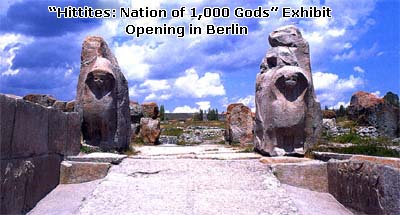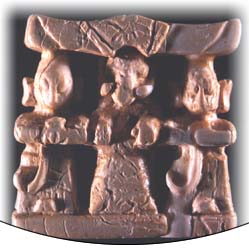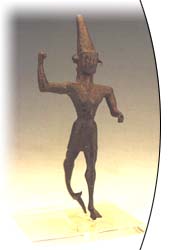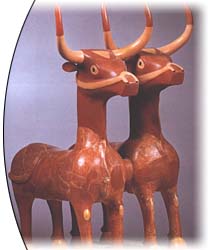"Hittites: Nation of 1,000 Gods" Exhibit Opening in Berlin

After its grand opening this January 17 attended by Turkish Culture Minister
M. İstemihan Talay, the exhibition “The Hittites: Nation of 1,000 Gods” was on
display at Bonn, Germany’s Federal Exhibit Hall through June 9, attracting great
attention and acclaim all along the way. Now the very same exhibit is set to
open in Berlin.
 The
ancient Hittite’s first political union was established near the crescent of the
Kızılırmak River in Anatolia around 2000 B.C. Exactly when and what route they
took into Anatolia is not known for certain, but the currently prevailing theory
holds that they came via the Caucasus together with the Palas and Luwis peoples,
two Indo-European tribes, towards the end of 3000 B.C. The capital of the
Hittite Empire was Hattuşaş (Boğazköy) and, covering an area of about two square
kilometers, it was one of the largest cities of its time.
The
ancient Hittite’s first political union was established near the crescent of the
Kızılırmak River in Anatolia around 2000 B.C. Exactly when and what route they
took into Anatolia is not known for certain, but the currently prevailing theory
holds that they came via the Caucasus together with the Palas and Luwis peoples,
two Indo-European tribes, towards the end of 3000 B.C. The capital of the
Hittite Empire was Hattuşaş (Boğazköy) and, covering an area of about two square
kilometers, it was one of the largest cities of its time.
Although influenced by both Mesopotamia and the Hurrian people, the Hittites
managed to preserve their own national identity. Through this interaction they
formed a truly unique synthesis. According to written archives, they were ruled
by a federal state system and they had a king. The king and queen exercised
equal authority between themselves. Hittite society, on the other hand, was made
up of classes of nobles, free people and slaves.
The Hittites’ tongue belongs to the Indo-European family of languages. In
their writing the Hittites used cuneiform and hieroglyphics, and they employed
the Akkadian language in official correspondence.
 The
Hittites were a richly polytheistic people. Their greatest gods were Teşup,
their storm god, and Hepatu, their sun god. They had an organized army, yet were
a peace-loving people. The greatest war in their history was the Kades War which
they waged against the Egyptians. At the conclusion of this war they signed with
the Egyptians the very first written agreement in history, the Treaty of Kades,
and this very important document has survived down to our day.
The
Hittites were a richly polytheistic people. Their greatest gods were Teşup,
their storm god, and Hepatu, their sun god. They had an organized army, yet were
a peace-loving people. The greatest war in their history was the Kades War which
they waged against the Egyptians. At the conclusion of this war they signed with
the Egyptians the very first written agreement in history, the Treaty of Kades,
and this very important document has survived down to our day.
The Hittites ruled Anatolia for 400 years until around 1200 B.C., when they
fell in defeat and disappeared into the sands of time.
Currently, Turkish archaeologists are doing excavations and restorations of
Hittite remains in the areas of Karatepe-Aslantas, Kayseri-Kultepe, Dorylelon
(Sarhöyük), Sapinuwa (Ortaköy) and Alacahöyük. Teams of foreign archaeologists
are also excavating in Hattuşaş (Boğazköy), Aslantepe-Malatya, and Sivas
Kusakli-Basoren. Other rich Hittite settlements and ruins can be found in
Inandik, Eskiyapar, Alacahöyük and Alisar.
In these excavations, some of which have been going on since 1893,
archaeologists have discovered a large number of clay tablet records and over 30
temples.
In 1997, the groundwork began to be laid to put together this special
exhibition, “The Hittites: A Nation of 1,000 Gods,” and for its voyage to Bonn.
Over 150 pieces were carefully chosen and assembled from museums in Alacahöyük,
Corum, Boğazköy, Kayseri, Sivas, Konya, Kastamonu, Karaman, Amasya, Afyon ,
Adana, Kahramanmaras, Gaziantep and Urfa, as well as the Istanbul Archaeology
Museum and Ankara’s Museum of Anatolian Civilizations. Seven historical
reconstructions are also displayed in this exhibit.
 A
copy of the historical Treaty of Kades signed between the Hittites and the
Egyptians is among the rich pieces exhibited. Other historical treasures on
display include stone reliefs, clay tablets, seals, miniature bronze sculptures,
ceramic pottery and valuable gold objects. Just like the “Troy: Dreams and
Reality” show before it, this special Hittite exhibit has attracted great
attention and acclaim, and over a quarter of a million people to date have had
the pleasure of seeing it. The exhibition will move to the Martin-Gropius
building in Berlin with the financial support of the Prussian Culture
Foundation, and the Berlin State Museums Front Asia Department.
A
copy of the historical Treaty of Kades signed between the Hittites and the
Egyptians is among the rich pieces exhibited. Other historical treasures on
display include stone reliefs, clay tablets, seals, miniature bronze sculptures,
ceramic pottery and valuable gold objects. Just like the “Troy: Dreams and
Reality” show before it, this special Hittite exhibit has attracted great
attention and acclaim, and over a quarter of a million people to date have had
the pleasure of seeing it. The exhibition will move to the Martin-Gropius
building in Berlin with the financial support of the Prussian Culture
Foundation, and the Berlin State Museums Front Asia Department.
The opening in Berlin is being realized by the undersecretary of our
ministry, Fikret Nesip ÜÇCAN, on the 11th of July in 2002, and we are expecting
that the same interest and admire of the exhibition in Bonn will also draw
significant attention in Berlin.
Picture Gallery